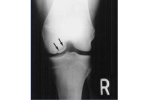Cartilage defects of the knee: Sports Docs Episode with Dr. Logan

Welcome to The Sports Docs Podcast with Dr. Catherine Logan and Dr. Ashley Bassett. On each episode we chat about the most recent developments in sports medicine and dissect through all the noise so you know which literature should actually impact your practice.
On today’s episode we’re focusing on cartilage defects of the knee with Dr. Clayton Nuelle, Assistant Clinical Professor at the University of Missouri and team physician for Mizzou athletics. His current research focuses on improving cartilage restoration and joint preservation techniques, so we are very excited to have him join us for our discussion today.
We have some great articles for you that contribute well to our conversation on the surgical treatment of knee cartilage disease.
We start with a discussion of osteochondral lesions in the pediatric population. Will Bugbee and his team at Scripps Clinic in California authored a case series titled “Osteochondral Allograft Transplantation of the Knee in the Pediatric and Adolescent Population”. They reported 90% graft survivorship at 10 years post-op. Of the five grafts that failed, four successfully underwent a salvage surgery with another osteochondral allograft. 88% of knees were rated as good to excellent with an 89% satisfaction rate. The authors deemed OCA to be a safe and effective procedure for pediatric patients with large osteochondral defects.
Then, from the December 2021 issue of Cartilage, we discuss the comprehensive review article by Andreas Gomoll and colleagues titled “Algorithm for Treatment of Focal Cartilage Defects of the Knee: Classic and New Procedures.” This paper nicely details a treatment approach based on cartilage lesion size, location and presence of underlying bone involvement.
We finish up our conversation with a focus on rehab and returning to play after cartilage restoration procedures. The last article we reference is a systematic review published in AJSM 2009 titled “Return to Sports Participation After Articular Cartilage Repair in the Knee.” Kai Mithoefer et al reported an overall return to sports rate of 73%, with the highest return rates following OATS. Yet, the highest durability to continue playing at the preinjury level of play was following ACI at 96%. There were numerous factors that impacted an athletes ability to return to sport. Younger patients, those with pure cartilage lesions rather than osteochondral lesions, duration of symptoms less than 12 months pre-op, smaller lesions under 2 cm, lesion location at the lateral femoral condyle, no prior surgeries and no concomitant procedures were all associated with increased return to play.



